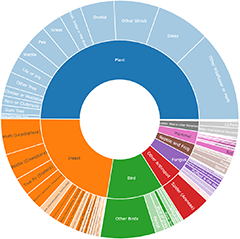Peas
There are over 12,000 pea species across the globe including herbs, shrubs, climbers and trees. They are good colonisers of bare areas assisted by their ability to trap nitrogen from the air and increase soil fertility. Many of the native species are dispersed by ants and will flourish after fire.
The native herbs and smaller shrubs are vulnerable to live-stock grazing and mainly occur in areas where grazing has been excluded or intermittent, such as within some Travelling Stock Reserves.
Although relatively few in number woody introduced peas, such as brooms, Gorse or Tree Lucerne are significant weeds. Exotic woody peas are a poor planting choice, as they are likely to stray far beyond the garden path.
All flowers of this family have the “sweet pea” butterfly shape, comprised of five often brightly coloured petals: the large upright standard at the back, two small lateral wings and the lower keel of two petals that are mostly fused.
Pea plants are generally distinguished from each other by their form (herb, shrub etc), their leaf characteristics, the colour of their flowers and the size and shape of their seed pods. Ideally postings of pea plants will include photographs that encapsulate all these features.
Photographs should show whether leaves are a single blade, or if not the number of leaflets of which they are composed. Photographs should also try and capture the pair of stipules or appendages that may occur at the base of the leaf stem. They can be leaf-like, membranous or spine like.
Announcements
We are super proud to welcome Edgar McNamara @edgarmcnamara to the team!Edgar joins NatureMapr as Junior Platform Engineer and will play a critical role in supporting the platform and our valued custo...
Continue reading
Platform wide attribute changes
New Feature: Moderator Quick Responses!
New priority species lists in the ACT
NatureMapr now receives more records in NSW than ACT
Discussion
Eutaxia (Genus)
Ornithopus compressus
Indigofera adesmiifolia
Top contributors
- Tapirlord 679
- trevorpreston 523
- Mike 437
- MichaelBedingfield 351
- JaneR 292
- KylieWaldon 224
- BettyDonWood 214
- NedJohnston 208
- ConBoekel 199
- MatthewFrawley 181
Top moderators
- Tapirlord 3.2K
- MichaelMulvaney 1.6K
- BettyDonWood 833
- MichaelBedingfield 638
- natureguy 575
- plants 305
- Venture 303
- RWPurdie 226
- Darcy 189
- Csteele4 90



